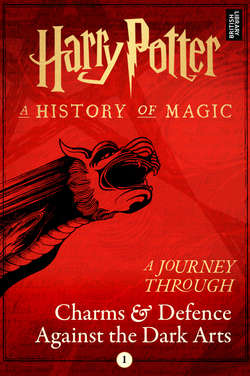Читать книгу A Journey Through Charms and Defence Against the Dark Arts - Pottermore Publishing - Страница 3
На сайте Литреса книга снята с продажи.
CHARMS
ОглавлениеPART 1: FROM ABRACADABRA TO AMORTENTIA
Harry Potter simply wouldn’t be Harry Potter without spells and charms. There would be no Wingardium Leviosa, no Riddikulus and no charmed objects like the Marauder’s Map – not even a flying broomstick.
To become invisible, to make someone fall in love with you, to transform into another creature – these are all things that people have believed in, yearned for or feared throughout history. There’s nothing more magical than a magic charm.
And perhaps one of the most powerful magic words of all is ‘Abracadabra!’
‘Avada Kedavra!’ Moody roared.
There was a flash of blinding green light and a rushing sound, as though a vast, invisible something was soaring through the air – instantaneously the spider rolled over onto its back, unmarked, but unmistakably dead.
Harry Potter and the Goblet of Fire
Known today for its use by stage magicians when they perform illusions, ‘Abracadabra’ is probably familiar to us all. But it has more sinister connotations as well. Londoners used to paint it on their doors to ward off the plague in the 17th century. The infamous 20th-century English occultist Aleister Crowley believed it to be a word that held great power. Its power is certainly felt in the Harry Potter stories.
Its origins stretch back to Roman times. The word is first documented in the Liber Medicinalis (‘The Book of Medicine’), written by Quintus Serenus Sammonicus, who lived in the 2nd century AD and was physician to the Roman Emperor Caracalla. Sammonicus was actually executed by Caracalla in 212 AD, as part of a broader purge, but before then he’d suggested using the term he had coined as a cure or prevention against catching malaria, which he called hemitritaeos. Sufferers were instructed to write down the ‘Abracadabra’ charm repeatedly, leaving out one letter each time. This would create a ‘cone-shaped’ text, which looked like an inverted triangle standing on its point. The charm was then worn as an amulet designed to drive out fever. Who would have thought that battling mosquitoes would set the stage for the most dangerous spell in the wizarding world?
While ‘Abracadabra’ is a famous word that we know from a historically significant text, some charms have almost been lost to history. One of these was found on a tiny fragment of paper tucked inside an 18th-century magical text from Ethiopia, but it has the potential to be particularly powerful: it tells you how to turn yourself into a lion.
It was quite common in Ethiopia for magical practitioners to make collections of charms, spells and names of plants and their properties, which were copied down. The invocation to turn yourself into a lion was found hidden in one of the resulting handbooks. It was written in an ancient Ethiopian language – Ge’ez – and it’s hard to tell just how old the fragment is. It might date from the same time, or from even earlier than the manuscript in which it was found.
Although Ethiopia was declared a Christian country in the 3rd century AD, it didn’t lose its Babylonian, Egyptian and Islamic influences. The indigenous African magic tradition was vying with new influences from outside the culture. This particular talisman to change yourself into a lion or serpent is an early example of the type of Transfiguration that we know so well from Professor McGonagall’s classes.
Changing yourself into a lion was not a straightforward process: it required outside assistance. This came in the form of specialised Ethiopian magic practitioners called Däbtäras. Why you might seek them out varied, but if you wanted to transform yourself into a lion or a similar beast, it might be because you were at war – or in need of an aggressive, attacking presence.
Whether the magic worked or not was said to depend on outside circumstances. Sometimes the magic was interfered with by a witch or a counter-prayer against the spell itself. We might think today that the idea of a charm working like this is a little hard to believe, but Däbtäras have practised in Ethiopia for centuries and continue to do so.
‘Transfiguration is some of the most complex and dangerous magic you will learn at Hogwarts,’ she said. ‘Anyone messing around in my class will leave and not come back. You have been warned.’
Then she changed her desk into a pig and back again.
Professor McGonagall – Harry Potter and the Philosopher’s Stone
Charms have the power to allow entry into Diagon Alley, and are also key to keeping its secrets. The bustling centre of wizarding retail therapy is where Harry acquires his holly and phoenix-feather wand (and other necessities) before setting off for his first term at Hogwarts.
